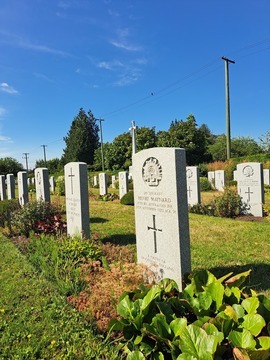
MAYNARD, Henry
| Service Number: | 285 |
|---|---|
| Enlisted: | Not yet discovered |
| Last Rank: | Private |
| Last Unit: | 17th Infantry Battalion |
| Born: | Kingsteignton, Devon, England , 2 March 1882 |
| Home Town: | Not yet discovered |
| Schooling: | Not yet discovered |
| Occupation: | Labourer |
| Died: | Nephritis , Vancouver General Hospital , 29 September 1920, aged 38 years |
| Cemetery: |
Vancouver (Mountain View) Cemetery Henry is the only Australian amongst the 588 service men in the CWGCs plots in the Vancouver Mountain View Cemetery. His grave is in the main CWGC Plot, in the fourth row in from the back, to the right of the cross of Remembrance. |
| Memorials: |
World War 1 Service
| 12 May 1915: | Involvement Private, 285, 17th Infantry Battalion, --- :embarkation_roll: roll_number: '12' embarkation_place: Sydney embarkation_ship: HMAT Themistocles embarkation_ship_number: A32 public_note: '' | |
|---|---|---|
| 12 May 1915: | Embarked Private, 285, 17th Infantry Battalion, HMAT Themistocles, Sydney |
Help us honour Henry Maynard's service by contributing information, stories, and images so that they can be preserved for future generations.
Add my storyBiography contributed by Anthony Vine
SERGEANT HENRY MAYNARD ON/19, 2nd TROPICAL FORCE ANMEF/ ON/285, 17TH BATTALION AIF
Henry Maynard was born in Kingsteignton, Devon England on the 8th of March 1882. Henry was the son of William and Ann Maynard. He had two brothers, John and George and three sisters, Elizabeth, Eva and Emma. On leaving school Henry worked as a Clay Cutter.
In 1906 Henry moved to British Colombia, Canada where he worked as a Labourer. In June 1908 he travelled to San Francisco, probably enroute to Australia.
In December 1914 Henry, a single man, enlisted in Brisbane in the “2nd Tropical Force”. The unit was raised as the 2nd Battalion of the ANMEF and it served in New Guinea. He served with the force until it returned to Australia. Henry transferred to the AIF on the 1st of March 1915. Whilst under training at Liverpool he was convicted of failing to obey the orders of an officer.
He embarked for the Middle East in Sydney on HMT (A32) Themistocles as a foundation member of the 17th Battalion AIF. The 17th trained in Egypt before landing on Gallipoli on the 20th of August 1915. The battalion remained on the peninsula until the evacuation in December 1915.
The 17th Battalion reformed in Egypt before arriving in France in March 1916. It first moved into the Front Line in April, and in July it took part in the Battle for Pozieres, where Henry was wounded in the shoulder on the 27th of July and treated at a Field Hospital in France. He returned to the Battalion in late August and was promoted to Lance Corporal in October. He was wounded a second time in late 1916, a gunshot wound to the back and evacuated to England in early December and treated at the 3rd Western General Hospital. He would not rejoin the battalion until early April 1917.
Within days of arriving back with his battalion, Henry was again in battle at Lagincourt and then in the Battle for Bullecourt. The casualties were such that Henry was promoted to substantive Corporal on the 5th of May, and made a Temporary Sergeant on the same day. He was confirmed in rank as a Sergeant in August 1917.
On the 5th of November he received a severe gunshot wound to his left knee and after treatment he was evacuated to England for a second time. He returned to France in February, however by April 1918 he was again evacuated, this time with illness – Nephritis or inflammation of the kidneys. He had suffered from mild Nephritis in late 1917 but had not been hospitalised at that time. This time is was more severe and in June he was reviewed by a Medical Board. The board deemed that he was to be returned to Australia for discharge on medical grounds. He departed England in July, arriving in Melbourne in September 1918. He discharged from the AIF in Brisbane in December 1918. There are no indications on his service file that he was afforded a pension.
In September 1919 Henry returned to Vancouver. At a time when kidney disease was largely incurable, his health deteriorated and on the 29th of September 1920, he passed away from Nephritis in Vancouver General Hospital. On admission to hospital he had nominated a friend, Mrs Rabjohn, of Frazer Street Vancouver, as his next of kin.
As Henry passed away from an illness contracted whilst on service, and as he died during the recognised period for war casualties, his death is considered to be a war death. He appears on the Australian War Memorial’s Roll of Honour. Henry is buried in the Main Commonwealth War Graves plot within the Vancouver Mountain View Cemetery. He is the only Australian serviceman amongst 588 war graves in the cemetery. The vast majority of the graves are men who, like Henry, died of wounds or illness after returning to Canada during the Great War.
Vale Henry Maynard.










